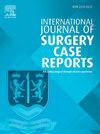Florid cystic endosalpingiosis: Diagnostic challenges and management in the spectrum of müllerian anomalies – A case report
IF 0.6
Q4 SURGERY
引用次数: 0
Abstract
Introduction and importance
Cystic endosalpingiosis is a rare, benign condition characterized by the presence of fallopian tube-like epithelium outside the fallopian tubes. It predominantly affects menopausal women and is often asymptomatic. Florid cystic endosalpingiosis, an unusual form, can mimic malignant ovarian masses, making accurate diagnosis crucial.
Case presentation
We present a 48-year-old postmenopausal woman with chronic pelvic pain, found to have a suspicious multicystic mass during ultrasound. Laparoscopic exploration revealed extensive cystic endosalpingiosis involving the uterine surface and left adnexa. Histopathological analysis confirmed the diagnosis.
Clinical discussion
Endosalpingiosis often presents a diagnostic challenge due to its nonspecific symptoms and potential to mimic neoplastic conditions. This case underscores the need for histological examination to differentiate between benign and malignant pelvic masses. Surgical resection is recommended for symptomatic cases, while asymptomatic ones may not require intervention.
Conclusion
Florid cystic endosalpingiosis should be considered in the differential diagnosis of multicystic pelvic masses in menopausal women. Accurate histological diagnosis is essential to exclude malignancy and guide appropriate management.
绚丽囊性输卵管内腔病:诊断挑战和管理在频谱的勒氏管异常-一个病例报告。
导言和重要性:囊性输卵管内膜异位症是一种罕见的良性疾病,其特征是输卵管外有类似输卵管的上皮细胞。它主要影响绝经期妇女,通常没有症状。弗洛里德囊性输卵管内膜增生症是一种不常见的疾病,可与恶性卵巢肿块相似,因此准确诊断至关重要:我们为您介绍一位 48 岁的绝经后妇女,她患有慢性盆腔疼痛,超声检查发现她有一个可疑的多囊性肿块。腹腔镜检查发现子宫表面和左侧附件广泛囊性内膜增生。组织病理分析证实了这一诊断:临床讨论:子宫内膜异位症通常是诊断上的难题,因为它的症状没有特异性,而且有可能与肿瘤病症相似。本病例强调了进行组织学检查以区分盆腔肿块良恶性的必要性。有症状的病例建议手术切除,无症状的病例可能不需要干预:结论:在更年期女性多囊性盆腔肿块的鉴别诊断中,应考虑到花叶囊性内膜异位症。准确的组织学诊断对于排除恶性肿瘤和指导适当的治疗至关重要。
本文章由计算机程序翻译,如有差异,请以英文原文为准。
求助全文
约1分钟内获得全文
求助全文
来源期刊
CiteScore
1.10
自引率
0.00%
发文量
1116
审稿时长
46 days

 求助内容:
求助内容: 应助结果提醒方式:
应助结果提醒方式:


